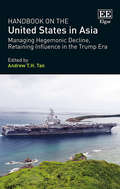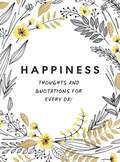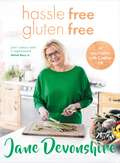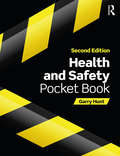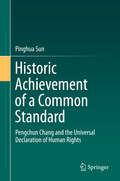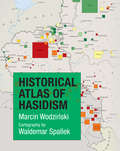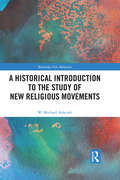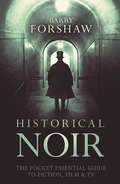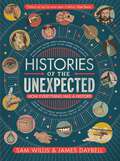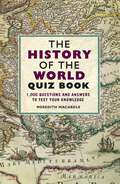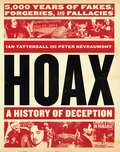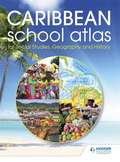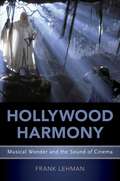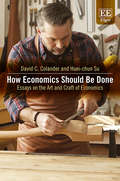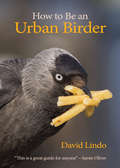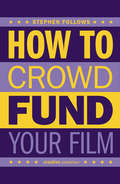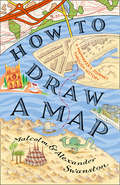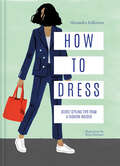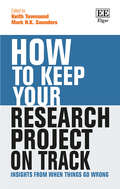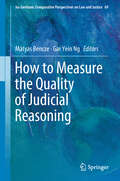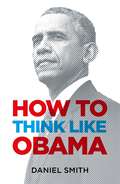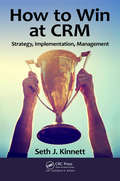- Table View
- List View
Handbook on the United States in Asia: Managing Hegemonic Decline, Retaining Influence in the Trump Era
by Andrew T. H. TanThe centre of gravity in today’s global economy arguably now resides in Asia. As a result of this, the maintenance of geopolitical and economic security in Asia has become pivotal to global stability. This indispensable Handbook examines the crucial and multifaceted role of the United States as a force in the region that has been, and continues to be, necessary for the continuation of Asian prosperity. The Handbook on the United States in Asia moves the academic discussion away from the fixation on America’s influence in terms of the China threat. It provides readers with comprehensive and informed coverage from expert international contributors on the engagement of the United States with a wide array of Asian countries. The Handbook examines America’s relationship with key allies as well as its multifaceted role and presence in the region. It also explores ways in which this is changing under Donald Trump’s presidency. The policy-orientated focus of this Handbook ensures that academic and governmental policy analysts will greatly benefit from the timely and comprehensive assessment of the book. Undergraduate and postgraduate international relations students, as well as Asian studies scholars, will also find it to be an excellent tool for study.
Happiness: Thoughts and Quotations for Every Day
by Summersdale PublishersImmerse yourself in the uplifting pages of this beautiful little book, filled with inspiring and motivational quotes from the world’s best writers, leaders and thinkers.Within this charming volume you will find a dose of happiness on every page. Featuring the wise words of luminaries ranging from Emily Dickinson to Mahatma Ghandi, and from Leo Tolstoy to Lao Tzu, this book will inspire your heart and ease your mind, helping you to see beauty in the everyday and inviting you to bask in the glow of positive thinking.With one pearl of wisdom per page, this book is the perfect gift for anyone who is looking for a spark of inspiration. It’s a pocket-sized reminder that there is joy to be found all around us.Happiness makes up in height for what it lacks in length.Robert FrostFind ecstasy in life; the mere sense of living is joy enough.Emily DickinsonThe best way to cheer yourself up is to try to cheer somebody else up.Mark Twain
Hassle Free, Gluten Free: Over 100 delicious, gluten-free family recipes
by Jane Devonshire'I hope that first and foremost this book is just a series of recipes that you can use for every day cooking; be it for a special occasion or a simple family supper. It's the things I cook and the little twists that I add that make my life easier and hopefully tastier; it just happens to be gluten free.'In her debut cookbook, Jane Devonshire presents 100 delicious recipes guaranteed to make you feel good, and wow family and friends. In chapters such as nibbles and small dishes or dinner and food for guests, Jane offers recipes from soups and dips to casseroles, arancini and delicious salads. Desserts include Chinese-style caramelized pineapple and a much-loved classic of steamed sponge pudding, while Jane also includes a chapter on baking (notoriously tricky for those on a gluten-free diet), from brownies to muffins and everything in between. Published to coincide with their 50th anniversary, the recipes are gluten-free and tested by Coeliac UK. Beautiful photography by Mike Cooper appears throughout.
Health and Safety Pocket Book
by Garry HuntThe second edition of the Health and Safety Pocket Book has been fully revised and updated to include all the relevant legal, HSE ACoP/Guidance and practice references. It remains a handy reference tool for practising health and safety professionals, auditors, managers, HR personnel, employee representatives and anyone with health and safety responsibilities.The book is an essential compilation of guidance, data and checklists covering a wide range of health and safety topics, supported by extensive key glossary terms. The A–Z arrangement within the chapters and extensive cross-referencing make it easy to navigate, while its size and scope make it the ideal volume for ready reference and site visits. The book will also be useful for health and safety courses at all levels.Key features include: The principal health and safety legal requirements for every industry Safety management elements and systems Checklists for major hazards affecting all industries A wealth of charts, hard-to-remember details and data A glossary of the main concepts of health and safety A list of important health and safety courses, publications and organisations Revision tips for key examination themes.
Historic Achievement of a Common Standard: Pengchun Chang and the Universal Declaration of Human Rights
by Pinghua SunThe subject of this book is human rights law, focusing on historic achievement of a common standard viewed from a perspective of Pengchun Chang’s contributions to the drafting of the Universal Declaration of Human Rights (UDHR). This is an original research, integrating different research methods: inter-disciplinary approaches, historical and comparative methods, and documentary research and so on. The research findings can be described briefly as follows: Chinese wisdom has played an important role in achieving a common standard for the establishment of the international human rights system, which can be seen by exploring P. C. Chang’s contributions to the drafting of the UDHR. The target readers are global scholars and students in law, politics, philosophy, international relations, human rights law, legal history, religion and culture. This book will enable these potential readers to have a vivid picture of the Chinese contributions to the international human rights regime and to have a better understanding of the significance of the traditional Chinese culture and P. C. Chang’s human rights philosophy of pluralism.
Historical Atlas of Hasidism
by Marcin WodzińskiThe first cartographic reference book on one of today’s most important religious movementsHistorical Atlas of Hasidism is the very first cartographic reference book on one of the modern era's most vibrant and important mystical movements. Featuring sixty-one large-format maps and a wealth of illustrations, charts, and tables, this one-of-a-kind atlas charts Hasidism's emergence and expansion; its dynasties, courts, and prayer houses; its spread to the New World; the crisis of the two world wars and the Holocaust; and Hasidism's remarkable postwar rebirth.Historical Atlas of Hasidism demonstrates how geography has influenced not only the social organization of Hasidism but also its spiritual life, types of religious leadership, and cultural articulation. It focuses not only on Hasidic leaders but also on their thousands of followers living far from Hasidic centers. It examines Hasidism in its historical entirety, from its beginnings in the eighteenth century until today, and draws on extensive GIS-processed databases of historical and contemporary records to present the most complete picture yet of this thriving and diverse religious movement.Historical Atlas of Hasidism is visually stunning and easy to use, a magnificent resource for anyone seeking to understand Hasidism's spatial and spiritual dimensions, or indeed anybody interested in geographies of religious movements past and present.Provides the first cartographic interpretation of HasidismFeatures sixty-one maps and numerous illustrationsCovers Hasidism in its historical entirety, from its eighteenth-century origins to todayCharts Hasidism's emergence and expansion, courts and prayer houses, modern resurgence, and much moreOffers the first in-depth analysis of Hasidism's egalitarian--not elitist—dimensionsDraws on extensive GIS-processed databases of historical and contemporary records
A Historical Introduction to the Study of New Religious Movements (Routledge New Religions)
by W. Michael AshcraftThe American public’s perception of New Religious Movements (NRMs) as fundamentally harmful cults stems from the "anticult" movement of the 1970s, which gave a sometimes hysterical and often distorted image of NRMs to the media. At the same time, academics pioneered a new field, studying these same NRMs from sociological and historical perspectives. They offered an interpretation that ran counter to that of the anticult movement. For these scholars in the new field of NRM studies, NRMs were legitimate religions deserving of those freedoms granted to established religions. Those scholars in NRM studies continued to evolve methods and theories to study NRMs. This book tells their story. Each chapter begins with a biography of a key person involved in studying NRMs. The narrative unfolds chronologically, beginning with late nineteenth- and early-twentieth century perceptions of religions alternative to the mainstream. Then the focus shifts to those early efforts, in the 1960s and 1970s, to comprehend the growing phenomena of cults or NRMs using the tools of academic disciplines. The book’s midpoint is a chapter that looks closely at the scholarship of the anticult movement, and from there moves forward in time to the present, highlighting themes in the study of NRMs like violence, gender, and reflexive ethnography. No other book has used the scholars of NRMs as the focus for a study in this way. The material in this volume is, therefore, a fascinating viewpoint from which to explore the origins of this vibrant academic community, as well as analyse the practice of Religious Studies more generally.
A Historical Introduction to the Study of New Religious Movements (Routledge New Religions)
by W. Michael AshcraftThe American public’s perception of New Religious Movements (NRMs) as fundamentally harmful cults stems from the "anticult" movement of the 1970s, which gave a sometimes hysterical and often distorted image of NRMs to the media. At the same time, academics pioneered a new field, studying these same NRMs from sociological and historical perspectives. They offered an interpretation that ran counter to that of the anticult movement. For these scholars in the new field of NRM studies, NRMs were legitimate religions deserving of those freedoms granted to established religions. Those scholars in NRM studies continued to evolve methods and theories to study NRMs. This book tells their story. Each chapter begins with a biography of a key person involved in studying NRMs. The narrative unfolds chronologically, beginning with late nineteenth- and early-twentieth century perceptions of religions alternative to the mainstream. Then the focus shifts to those early efforts, in the 1960s and 1970s, to comprehend the growing phenomena of cults or NRMs using the tools of academic disciplines. The book’s midpoint is a chapter that looks closely at the scholarship of the anticult movement, and from there moves forward in time to the present, highlighting themes in the study of NRMs like violence, gender, and reflexive ethnography. No other book has used the scholars of NRMs as the focus for a study in this way. The material in this volume is, therefore, a fascinating viewpoint from which to explore the origins of this vibrant academic community, as well as analyse the practice of Religious Studies more generally.
Historical Noir: The Pocket Essential Guide to Historical Fiction, Film and TV
by Barry ForshawIt's one of the most successful - and surprising - of phenomena in the entire crime fiction genre: detectives (and proto-detectives) solving crimes in earlier eras. There is now an army of historical sleuths operating from the mean streets of ancient Rome to the Cold War era of the 1950s. And this astonishingly varied offshoot of the crime genre, as well as keeping bookshop tills ringing, is winning a slew of awards, notably the prestigious CWA Historical Dagger.Barry Forshaw, one of the UK s leading experts on crime fiction, has written a lively, wide-ranging and immensely informed history of the genre, which might be said to have begun in earnest with Ellis Peters crime-solving monk Brother Cadfael in the 1970s and Umberto Eco's The Name of the Rose in 1980 (with another monkish detective), but which has now taken readers to virtually every era and locale in the past.As in earlier entries in his Noir series, Forshaw has produced the perfect reader's guide to a fascinating field; every major writer is considered, often through a concentration on one or two key books, and exciting new talents are highlighted.'Historical Noir covers crime novels (and their authors) set in ancient Greece and beyond to the 1950s ... what a splendid, varied bunch Forshaw provides' - Times'A very worthy addition to this great series' - Crime SquadLook out for the other books in Barry Forshaw's Noir series, Euro Noir, Nordic Noir, Brit Noir and American Noir, and for his latest book, Crime Fiction: A Reader's Guide.
Histories of the Unexpected: How Everything Has a History (Histories Of The Unexpected Ser.)
by Dr Sam Willis Professor James Daybell'History as you've never seen it before.' Dan Snow'A wonderful, eclectic and entertaining history of everything, full of fascinating, surprising stories.' Suzannah LipscombDid you know that the history of the beard is connected to the Crimean War; that the history of paperclips is all about the Stasi; and that the history of bubbles is all about the French Revolution? And who knew that Heinrich Himmler, Tutankhamun and the history of needlework are linked to napalm and Victorian orphans?In Histories of the Unexpected, Sam Willis and James Daybell lead us on a journey of discovery that tackles some of the greatest historical themes - from the Tudors to the Second World War, from the Roman Empire to the Victorians - but via entirely unexpected subjects.By taking this revolutionary approach, they not only present a new way of thinking about the past, but also reveal the everyday world around us as never before.
The History of the World Quiz Book: 1,000 Questions and Answers to Test Your Knowledge
by Meredith MacArdleTaking the history of the world as its basis might seem a mammoth task but this fascinating book does just that, breaking the whole lot down into ten enthralling chapters that cover the ages and the world, from the Bronze Age up until the end of the Second World War.With over 5,500 years to choose from, and a whole world of events, you can be sure there is no shortage of intriguing history to explore. From the first empires and civilizations, through the Ancient world of the Middle East and Africa; the Parthian Empire; the Golden Age of India; the ancient dynasties of China; the founding of Rome and the Roman republic; Peruvian cultures; The Middle Ages; the Byzantine Empire; Mayan culture; the Crusades; the rise of the Ottoman Empire; the Renaissance – this far-reaching book will test the knowledge of any history lover and provide the ultimate challenge for even the most knowledgeable historian.With questions ranging through multiple choice, truth or fiction, maps and pictures, you will find there is always something new to learn about the world.
Hoax: 5,000 Years of Fakes, Forgeries, and Fallacies
by Ian Tattersall Peter NévraumontAn entertaining collection of the most audacious and underhanded deceptions in the history of mankind, from sacred relics to financial schemes to fake art, music, and identities. World history is littered with tall tales and those who have fallen for them. Ian Tattersall, a curator emeritus at the American Museum of Natural History, has teamed up with Peter Néaumont to tell this anti-history of the world, in which Michelangelo fakes a masterpiece; Arctic explorers seek an entrance into a hollow Earth; a Shakespeare tragedy is "rediscovered"; a financial scheme inspires Charles Ponzi; a spirit photographer snaps Abraham Lincoln's ghost; people can survive ingesting only air and sunshine; Edgar Allen Poe is the forefather of fake news; and the first human was not only British but played cricket. Told chronologically, HOAX begins with the first documented announcement of the end of the world in 2800 BC and winds its way through controversial tales such as the Loch Ness Monster and the Shroud of Turin, past proven fakes such as the Thomas Jefferson's ancient wine and the Davenport Tablets built by a lost race, and explores bald-faced lies in the worlds of art, science, literature, journalism, and finance.
Hodder Education Caribbean School Atlas (PDF)
by HodderFeel confident in full coverage of the curriculum requirements with an atlas specially created to cover Social Studies, Geography and History. - Encourage awareness of the whole Caribbean region with a 44-page Caribbean section, containing detailed maps of all independent countries and major dependent territories from The Bahamas to Trinidad, and including Belize and Guyana.- Engage students in topical issues with a world mapping section, including features on world climate, the environment and population. - Introduce a solid foundation in geographical knowledge with world facts and figures for all nations.- Secure strong geographical skills with a feature on map reading and how to use an atlas.- Ensure ease-of-use with a 4-page index showing letter-figure grid references to place names found on the maps.
HOLLYWOOD HARMONY OMMS C: Musical Wonder and the Sound of Cinema (Oxford Music/Media Series)
by Frank LehmanFilm music often tells us how to feel, but it also guides us how to hear. Filmgoing is an intensely musical experience, one in which the soundtrack structures our interpretations and steers our emotions. Hollywood Harmony explores the inner workings of film music, bringing together tools from music theory, musicology, and music psychology in this first ever book-length analytical study of this culturally central repertoire. Harmony, and especially chromaticism, is emblematic of the "film music sound," and it is often used to evoke that most cinematic of feelings-wonder. To help parse this familiar but complex musical style, Hollywood Harmony offers a first-of-its kind introduction to neo-Riemannian theory, a recently developed and versatile method of understanding music as a dynamic and transformational process, rather than a series of inert notes on a page. This application of neo-Riemannian theory to film music is perfect way in for curious newcomers, while also constituting significant scholarly contribution to the larger discipline of music theory. Author Frank Lehman draws from his extensive knowledge of cinematic history with case-studies that range from classics of Golden Age Hollywood to massive contemporary franchises to obscure cult-films. Special emphasis is placed on scores for major blockbusters such as Lord of the Rings, Star Wars, and Inception. With over a hundred meticulously transcribed music examples and more than two hundred individual movies discussed, Hollywood Harmony will fascinate any fan of film and music.
How Economics Should Be Done: Essays on the Art and Craft of Economics
by Huei-Chun Su David C. ColanderDavid Colander has been writing about economic methodology for over 30 years. His pragmatic approach sees applied policy methodology as rooted in what economists actually do, not in what methodologists say they should do. It sees applied policy methodology as constantly evolving as analytic and computational technology changes, evolving far too fast to be subject to any rigid scientific methodology. That problem is that economists generally think of applied policy analysis as applied science. Colander argues that using a scientific methodology to guide applied policy undermines good policy analysis. Instead, he contends that economists should use a much looser engineering methodology that blends science, heuristics, inescapable moral judgments, and creativity into what he calls the art and craft of economics. Here, Huei-chun Su has selected seventeen of Colander’s articles that spell out and capture his arguments at various levels – some formal academic articles dealing with cutting edge methodology, and some more popular articles making the case for his approach. An original introduction and annotated bibliography serve as excellent resources for further exploring his arguments. Clear, well-structured, and written in plain English with little jargon, the book is approachable and suitable for anyone interested in the current and future state of economics and the economics profession. This includes students at any level as well as methodologists, applied economists, historians and critics of modern economics.
How to Be an Urban Birder (WILDGuides #13)
by Jamie Oliver David LindoThe first guide to urban birding in the UK, from The Urban Birder himself, David LindoUrban birding is fast becoming ornithology’s new rock ’n’ roll. Birds and birding have never been cooler—and urban birding is at the cutting edge.How to Be an Urban Birder is the world’s first guide to the art of urban birding—which is so easy and great fun! Here, urban birding pioneer David Lindo tells you everything you need to know about birds and birding in towns and cities in the UK.Includes a brief history of urban birding in the UKCovers the best places to look for birds in towns and citiesHelps you get to know your urban birdsGives useful tips on how to attract birds to your gardenExplains what gear you need and how to go about being an urban birderFeatures hundreds of cool images and illustrations of birds in urban settings
How to Be an Urban Birder (WILDGuides #13)
by David Lindo Jamie OliverThe first guide to urban birding in the UK, from The Urban Birder himself, David LindoUrban birding is fast becoming ornithology’s new rock ’n’ roll. Birds and birding have never been cooler—and urban birding is at the cutting edge.How to Be an Urban Birder is the world’s first guide to the art of urban birding—which is so easy and great fun! Here, urban birding pioneer David Lindo tells you everything you need to know about birds and birding in towns and cities in the UK.Includes a brief history of urban birding in the UKCovers the best places to look for birds in towns and citiesHelps you get to know your urban birdsGives useful tips on how to attract birds to your gardenExplains what gear you need and how to go about being an urban birderFeatures hundreds of cool images and illustrations of birds in urban settings
How to Crowdfund Your Film: Tips and Strategies for Filmmakers
by Stephen FollowsCrowdfunding is a major source of funding for independent films and over $250 million has been raised for films just on Kickstarter alone. This book will guide you through every stage of planning, creating and running your film crowdfunding campaign.This book is based on extensive data research and interviews which include:Data research on over 50,000 film crowdfunding campaignsInterviews with over 50 filmmakers who have run crowdfunding campaignsInterviews with some of the top people at major crowdfunding platforms and servicesPraise for Stephen Follows'Stephen drills down on data to discover truths about the film industry. Totally worth a read' - Ted Hope, Head of Production, Amazon Original Movies'Stephen's research is brilliant. No-one is doing data-driven analysis of the film industry quite like Stephen Follows. His detailed research and reporting about the film industry is unique and invaluable' - Jonathan Wolf, Head of The American Film Market'Stephen is one of the most gifted producers I know. His mind operates at an entirely different speed to almost everyone I know, solving problems, offering solutions and innovating new opportunities at breakneck speed' - Chris Jones, author of The Guerrilla Filmmakers HandbookPlease note that this is a fixed-format ebook file.
How to Draw a Map
by Malcolm Swanston Alex SwanstonHow to Draw a Map is a fascinating meditation on the centuries-old art of map-making, from the first astronomical maps to the sophisticated GPS guides of today.
How to Dress: Secret Styling Tips From A Fashion Insider
by Alexandra FullertonThe perfect book for anyone who wants to know the secrets to always looking stylish with minimal effort.
How to Keep Your Research Project on Track: Insights from When Things Go Wrong
by Keith Townsend Mark N. K. SaundersTextbooks and journal articles on research methods are rarely of help regarding what to do when your research project goes off track. This book addresses this important, and usually hidden, aspect of research by providing students and researchers with insider insights, advice and lessons about the difficulties in the research process. Written by experienced researchers, PhD supervisors and examiners, it should prepare the reader for all that can go wrong when researching a PhD or any large research project. The starting point of each chapter is the acceptance that research projects do not always go smoothly. Researchers must find ways to jump through a myriad of invisible hoops and over a plethora of hurdles of unknown heights to guide their research, from conceptualisation of worthwhile projects to the completion and dissemination to a range of different audiences. The book is divided into four sections: ‘getting started’, ‘getting data’, ‘getting it together’, and ‘getting finished’. Each section comprises chapters followed by short vignettes – all of which offer insights into researchers facing real-world problems or not quite getting things right in the first instance. This ground breaking book will give hope to the early-career researcher, the PhD or Masters student, and provide experienced academics with reinvigoration and new perspectives on the research process.
How to Measure the Quality of Judicial Reasoning (Ius Gentium: Comparative Perspectives on Law and Justice #69)
by Mátyás Bencze Gar Yein NgThis edited volume examines the very essence of the function of judges, building upon developments in the quality of justice research throughout Europe. Distinguished authors address a gap in the literature by considering the standards that individual judgments should meet, presenting both academic and practical perspectives. Readers are invited to consider such questions as: What is expected from judicial reasoning? Is there a general concept of good quality with regard to judicial reasoning? Are there any attempts being made to measure the quality of judicial reasoning? The focus here is on judges meeting the highest standards possible in adjudication and how they may be held to account for the way they reason. The contributions examine theoretical questions surrounding the measurement of the quality of judicial reasoning, practices and legal systems across Europe, and judicial reasoning in various international courts. Six legal systems in Europe are featured: England and Wales, Finland, Italy, the Czech Republic, France and Hungary as well as three non-domestic levels of court jurisdictions, including the Court of Justice of the European Union (CJEU). The depth and breadth of subject matter presented in this volume ensure its relevance for many years to come. All those with an interest in benchmarking the quality of judicial reasoning, including judges themselves, academics, students and legal practitioners, can find something of value in this book.
How to Think Like Obama (How to Think Like ...)
by Daniel SmithBe inspired by Barack Obama and learn how to think big with this unique insight into the mind of one of the world’s great influencers. Born to a black Kenyan father and white American mother, raised in Hawaii and, for a time, Indonesia, Barack Obama would typically never have been tipped for a future president of the United States, such was the world he was born into. But the path towards greatness and the choices he made along the way can be understood by an attitude that saw him take on any challenge – indeed, ‘Yes We Can’ became the all-inclusive slogan for his presidential candidacy.Riding a wave of positivity and hope for the future that swept him all the way to the Oval Office, Obama aimed to define his presidency as one that would provide opportunities for the many, not the few. With the price of change being gritty negotiation and compromise, Obama evolved the skills of a twenty-first century president which belied his relative inexperience to achieve the America that, as a young man, he had dreamed of. How to Think Like Obama reveals the motivations, inspirations and philosophies behind a man who broke the mould to challenge the status quo. With his thoughts on leadership, innovation, overcoming obstacles and fighting inequality, and with quotes by and about him, with this book you too can learn to think like Barack Obama.
How to Win at CRM: Strategy, Implementation, Management
by Seth KinnettThis book provides clarity and guidance on effective strategy, implementation and management of CRM. It explores both the conceptual and cultural context of CRM initiatives along with the particulars of CRM system implementation and management. In order to provide this clarity, it surveyed the existing academic publications surrounding CRM, sales force automation, and related topics within information systems literature. The book supplements this research with insights from CRM experts to provide a robust picture of the CRM landscape and how to improve it no matter what role you play within your organization. This book is for everyone who wants to achieve CRM success.
How to Win at CRM: Strategy, Implementation, Management
by Seth KinnettThis book provides clarity and guidance on effective strategy, implementation and management of CRM. It explores both the conceptual and cultural context of CRM initiatives along with the particulars of CRM system implementation and management. In order to provide this clarity, it surveyed the existing academic publications surrounding CRM, sales force automation, and related topics within information systems literature. The book supplements this research with insights from CRM experts to provide a robust picture of the CRM landscape and how to improve it no matter what role you play within your organization. This book is for everyone who wants to achieve CRM success.
